- Meaning
- Purpose
- Effects on Nadis
- Preparation
- How to do it
- Breathing ratio
- Contraindications
- Precautions
- Beginners Tips
- Nadi Shodhana Benefits
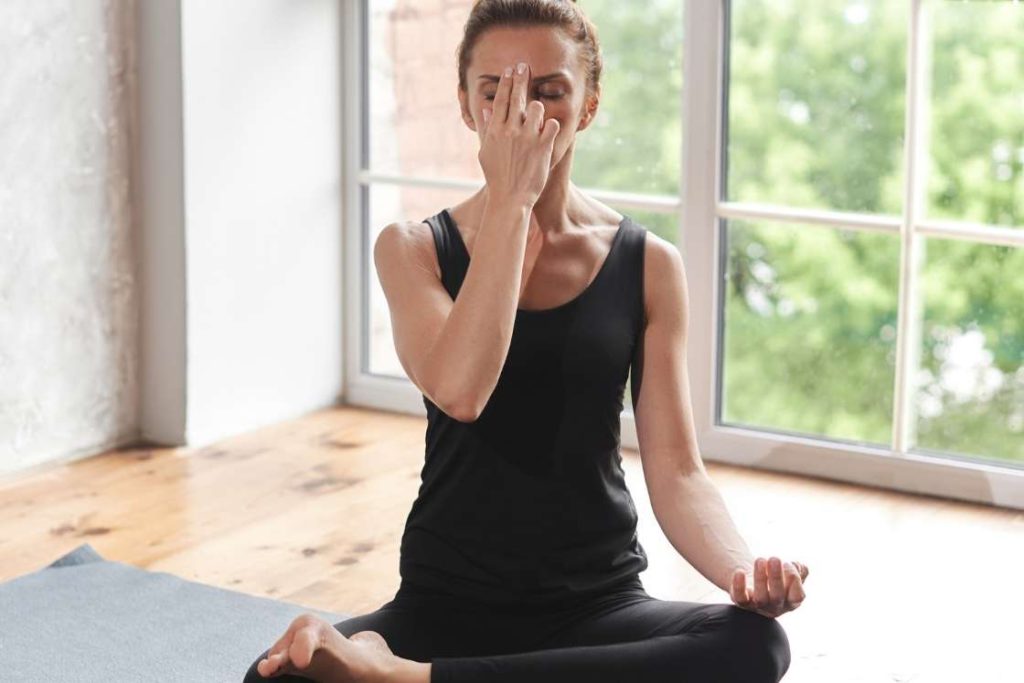
Nadi Shodhana is a purificatory pranayama breathing exercise to clean the Nadis from any kind of impurities. In this pranayama, breathing is done in an alternate manner, one-by-one from a single nostril at one time. Therefore it’s also called alternate nostril breathing.
After Nadi Shodhana Pranayama, you will feel a clear opening in your nasal passageway. Clear and fully open nostrils give the best results out of any pranayama. It makes Nadi shodhana a good preparatory exercise before beginning any other types of pranayama. In fact, this is the reason in Hatha Yoga Pradipika Nadi shodhan pranayama is described before 8 classical pranayamas.
The practice of Nadi Shodhana pranayama helps the mind to become still and tranquilize, which further eradicates the problems like stress and anxiety.
Meaning of Nadi Shodhana
Nadi Shodhana is a Sanskrit term where ‘Nadi‘ means ‘flow’ or ‘channel’ and ‘Shodhana‘ means to ‘Purify’. The purifying process of Nadi takes place when breathing is done continuously for a while in alternative nostrils.
The process of Nadis purification to awaken the central energy channel Sushumna is called “nadi shuddhi”. And the pranayama technique we use for “nadi shuddhi” process is called Nadi Shodhana Pranayama.
Purpose of Nadi Shodhana Pranayama
Yogic science explains energy in our body travels via some channels present in the subtle body called Nadis. Due to some physical and psychological factors like injury, stress, anxiety, and fear, etc. Nadis get blocked, which results in improper functioning of the body and mind.
There are three important Nadis Ida, Pingala, and Sushumna through which Prana energy spread into the 72,000 Nadis to flow into the whole body.
The purpose of Nadi Shodhana Pranayama is to clear all 72,000 Nadis so that there isn’t any obstruction in the flow of Prana. Hatha Yoga said after Asana practice when there is a surge of energy in the body, the role of Nadi Shodhana comes to purify Nadis before that energy spread throughout the whole body. Moreover, when the consistent practice of Nadi Shodhana activates and harmonizes Ida and Pingala Nadi, it leads to the opening of closed Sushumna Nadi. Further, the opening of Sushumna Nadi gives rise to the awakening of kundalini.
Effect of Nadi Shuddhi on Ida, Pingala, and Sushumna
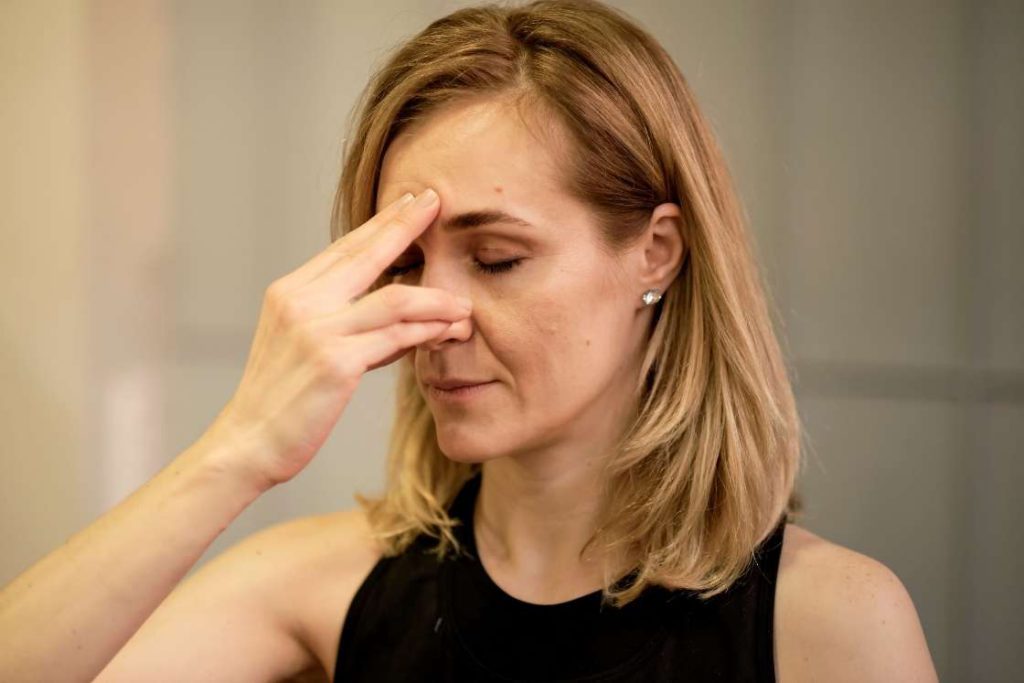
Ida and Pingala Nadis run on either side of the spinal column which when become balanced opens Sushumna Nadi, the central energy channel.
Ida Nadi represents the tamas guna, moon, coolness, or the feminine aspects that are associated with the left nostril. Whereas, the Pingala Nadi represents the rajas guna, heat, sun, and masculine space of the individual concerning the right nostril.
When an individual practices the Nadi Shodhana Pranayama, it results in balancing the Ida and Pingala Nadi or Left and Right brain hemisphere or Feminine and Masculine aspects. This results in the activation of the Sushumna Nadi the centermost Nadi runs through all of the seven chakras residing on the spine.
It further opens up the immense resources of health and wellness that guide the individual on the path of spiritual awakening. The ultimate path of life. Apart from that, it also ensures the functioning and efficiency of the respiratory system to maintain the further practice of Nadi Shodhana pranayama.
Preparation for Nadi Shodhana Pranayama
Before one begins the actual practice of Nadi Shodhana, especially the beginners in pranayama, it’s advised to know the basics of practice.
Nadi Shodhana Pranayama Mudra
In Nadi Shodhana Pranayama, a person can use Vishnu Mudra and Nasagra Mudra to close the nostrils in an easy manner and effectively. Both mudras are always made using the right hand only.
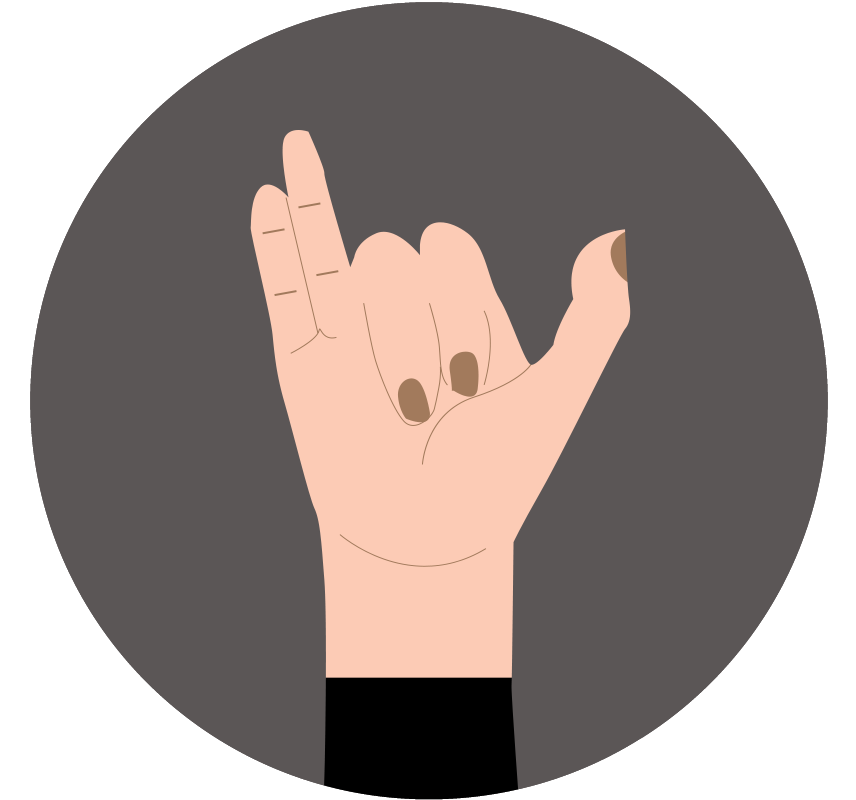
For Vishnu mudra, curl the index and middle finger of your right hand towards the palm. Now with the right thumb, the right nostril is closed and with the ring finger, the left nostril is close. To close nostrils in breath retention, thumb and ring fingers are pressed together.
People who feel discomfort in bending fingers while practicing can make Nasagra mudra.
For Nasagra mudra, the index and middle finger are extended up placed between the two eyebrows at the root of the nose. Nostrils are operated similarly to Vishnu mudra. However the working of both mudras are the same, but it becomes easier to concentrate in Nadi Shodhana with Nasagra mudra.
Inhale-exhale same nostril
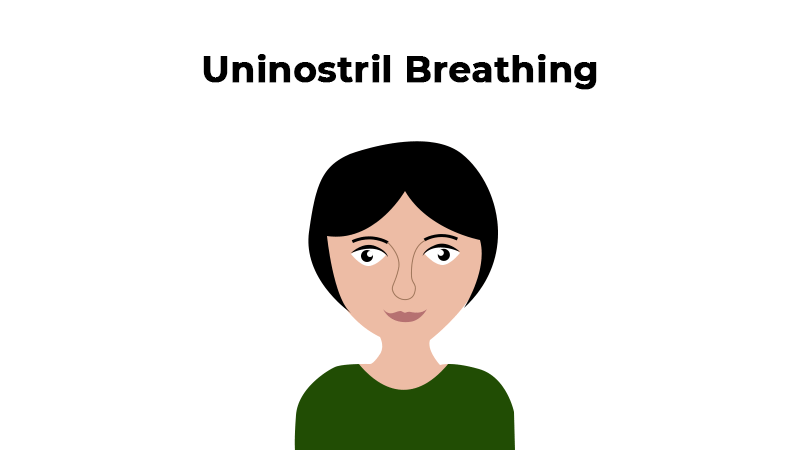
To fully open both nostrils before Nadi Shodhan Pranayama, always start with this simple breathing. Here inhale and exhale is done with a single nostril, called uninostril breathing.
- Sit in siddhasana. Close your right nostril with your right thumb, inhale deeply through the left nostril and exhale completely through the same nostril. Do it 10 times.
- Then close the left nostril with your right ring finger. Inhale and exhale in the same manner through right nostril – 10 times.
In this preparation, start with a breathing ratio of 1:1 then progressively work on 1:2.
Inhale-exhale opposite nostril at one time
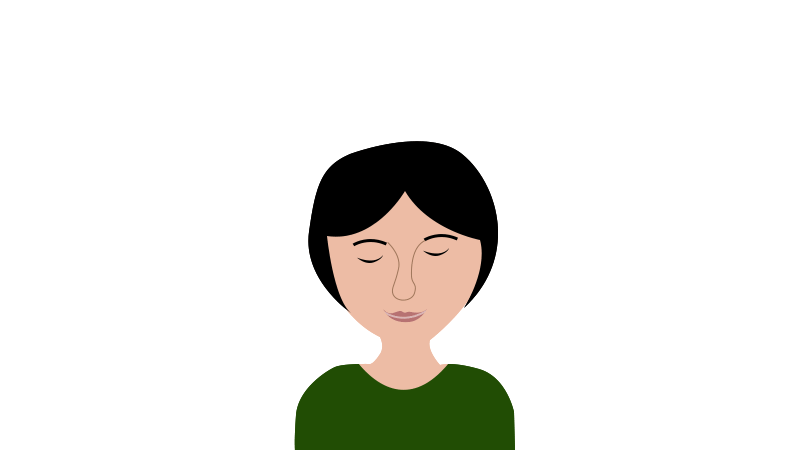
To harmonize the flow of breathing, work on inhalation-exhalation from opposite nostrils in one cycle.
- Sit as in the previous stage. Close the right nostril with the right thumb then take a deep breath through the left nostril. Close the left nostril with the right ring finger then exhale out the complete air. It’s one cycle.
- Repeat this cycle 10 times – inhale left and exhale right. It’s called Chandra Bhedana Pranayama.
- After the 10th round, reverse your breathing pattern i.e. firstly inhale through the right nostril while the left nostril close. And then exhale through the left nostril while the right nostril is close. It’s called Surya Bhedana Pranayama.
When Chandra bhedana and Surya Bhedana both are combined in one cycle, it becomes Nadi Shodhana Pranayama without breath retention.
How to Do Nadi Shodhana Pranayama?
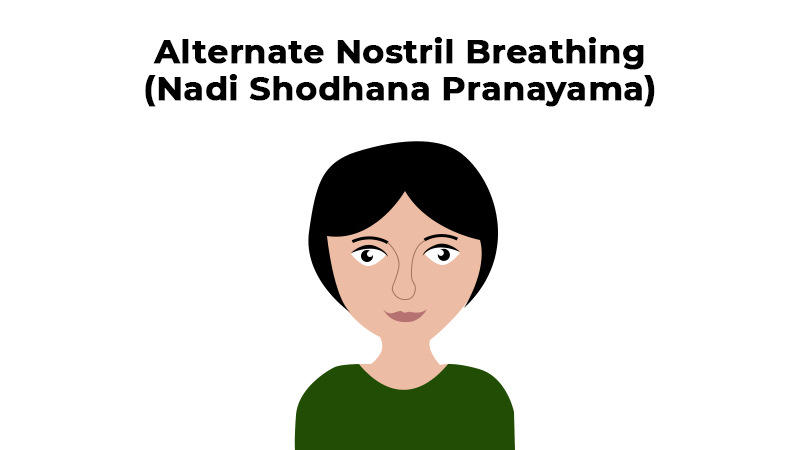 Source: Fitsri
Source: Fitsri
- Begin by sitting cross-legged in any comfortable posture as Siddhasana (accomplished pose), Sukhasana (easy pose), or Padmasana (Lotus Pose).
- Now, straighten up your backbone and neck along with aligning shoulder to each other, relax, and breath gently here. Left hand placed over the left kneecap.
- Make a hand mudra with your right hand, either Vishnu Mudra or Nasagra mudra.
- Lift your right arm at the shoulder level. Without dropping down, bend it from the elbow so the right-hand straightly comes in front of the nose.
- Begin the first cycle of Nadi Shodhana pranayama by closing the right nostril with thumb. Place thumb just below the boney part of your nose.
- Take a long deep breath in from the left nostril while expanding your chest.
- At the end of inhalation, close your open left nostril with your ring finger. Retain breath inside your body for a few seconds.
- Release the thumb from the right nostril, exhale slowly while feeling a contraction of the chest and abdomen.
- Then inhale deeply from the same right nostril, hold the breath inside and exhale out from the left nostril. It completes the one round of Nadi Shodhana Pranayama.
- Repeat the process in the same process. Do it 20 rounds in one time.
Breathing Ratio
As per yogic texts, the ratio of inhale, breath retention, and exhale in Nadi Shodhana Pranayama is 1:4:2.
Gheranda Samhita, a hatha yoga text suggest that Yogis under the guidance of Guru begins with 12 counts of inhalation, 48 counts of retention, and 24 counts of exhalation. With time and progressive increase, breath counts can be increased up to 20 inhalation, 80 retention and 40 exhalation.
However, for beginners who practicing Nadi Shodhana without any Guru’s guidance, it’s advised to start with a ratio of 1:1:1 and with a month of consistent practice increase this ratio up to 1:2:2. Then progressively build up the stamina to achieve the normal ratio of 1:4:2.
Moreover, In further higher stages, external breath retention (Kumbhaka) is added into Nadi Shodhana. It makes the breathing ratio look like this 1:4:2:2.
Contraindications of Nadi Shodhana Pranayama
- Avoid practicing Nadi Shodhana pranayama in the condition of cold or running nose. This would disturb the breathing or might choke the windpipe while breathing.
- Practitioners who are prone to dust particles or are allergic should avoid practice this pranayama around the dirt place. An open space with clear air or an indoor airy room could be the better option in this regard.
- Patients with sinus should avoid practicing Nadi Shodhana pranayama while they experience pain or inflammation in the nasal or throat region. The practice would hardly reach the desired results in such discomfort.
Precautions
- Practitioners with the condition of asthma and high blood pressure should avoid the retention of breath as it might be fatal if ignored.
- Feeling shortness of breath in Nadi Shodhana is a sign you’re pushing your breath beyond your normal limits. Stop the practice immediately when feeling lightheaded, dizzy, or nauseous.
- Individuals who are suffering from some kind of infection of the mouth, nose, throat, or lungs should avoid practicing Nadi Shodhana pranayama. Otherwise could cause a serious situation.
- The practice of this pranayama should not be done right after the meal and one should wait for a minimum of 3 to 4 hours to begin the practice.
Beginners Tips
- Beginners should avoid laying pressure on any of one side of the nose while practicing Nadi shodhana pranayama. This might be harmful to the soft tissue and cartilage of the nose.
- New Practioner should focus on deep and slow breathing rather than hurrying with the breath. This would not lead to the appropriate results in the end.
- Beginners should keep their spine straight that supplies enough space for the lungs and to the diaphragm for contraction and relaxation. This will deepens the effect of breath on the body.
Nadi Shodhana Pranayama Benefits
Nadi Shodhana Pranayama benefits the body and mind in many ways. It brings the brain in a balanced state to become mindful of the present moment. Here’s how it benefits;
1. Synchronize Brain Hemisphere
Nadi Shodhana pranayama helps in setting up a balance between the Ida and Pingala Nadi connected to the opposite hemisphere of the brain. On Inhaling through the left nostril, it activates the right hemisphere or parasympathetic nervous system (rest/relaxation response). And on inhaling through the right activates the left hemisphere or sympathetic nervous system (fight/flight response).
Nadi Shodhana ensures optimum functioning of both brain hemisphere along with coordination with each other.
2. Improves Blood circulation
The deep breathing n this pranayama improves blood circulation throughout the body, which enables the muscles, lungs, heart, and other organs to function brilliantly. As a result, it prevents diseases and strengthens immunity.
3. Develops Pulmonary Health, Keeps Lungs Healthy
Deep and slow breathing allows every part of the Pulmonary system like the nose, pharynx, larynx, trachea, bronchi, and lungs to function in a coordinated way. This results in the productive output in the face of improved respiratory capacity along with Volumes (expiratory Flow) [efn_note] immediate effect of ‘nadi -shodhana pranayama’ on some selected parameters of cardiovascular, pulmonary, and higher functions of brain https://www.ijhsr.org/IJHSR_Vol.9_Issue.10_Oct2019/7.pdf [/efn_note]
4. Promotes upliftment of Prana
The ultimate aim of the Nadi Shodhana Pranayama is to clear the pathway or Subtle energy channels for the Prana to flow freely. Breathing in this pranayama practice is so intense that it stimulates the Prana so efficiently, that balances the Ida and Pingala Nadis. This further stimulates Sushumna Nadi through which the spiritual energy is lifted up.
5. Helpful in Cardiovascular Health
According to one of the studies [efn_note] On Spectral Analysis of Heart Rate Variability during Very Slow Yogic Breathing https://ieeexplore.ieee.org/document/1616968?reload=true [/efn_note] , it has shown that Slow breathing like Nadi Shodhana Pranayama helps in significantly lowering the heart rate. This maintains the rhythmic pattern of the heart, which ensures healthy heart functioning.
6. Activates Sahashrara Chakra
When Ida Nadi and Pingala Nadi balance, this results in the awakening of the Sushumna Nadi that runs from the base of the spine (Mooladhara Chakra) to the crown of the head (Sahasrara Chakra). The prana flows swiftly through the central Nadi as it becomes clears by Nadi shodhana pranayama. Hence, reaches the crown chakra by crossing all the six chakras and activates Sahashrara in the end. It bless the practitioner with the spiritual consciousness, let go of the emotional blockages and peace of the mind.
Conclusion
Nadi Shodhana Pranayama or Alternate breathing is an effective practice that purifies the subtle channels called Nadis in which the life force called Prana flows freely without any disturbance.
This promotes the various aspects including mental, physical, and spiritual aspects of an individual. It also balances the ida and Pingala to balance the Sushumna which further activates Sahasrara chakra. This brings a spiritual upliftment in the life of the practitioners.





Really helpful. Thank you.
Hi there Lucasz and Lubi. Please check this article https://www.fitsri.com/yoga-mudras/vishnu-mudra. There is an explanation here why right hand is used here. Hope it helps.
Hello,
Thank you for that great explanation. I have some questions regarding using hands for mudra.
You wrote, “Both mudras are always made using the right hand only.” what if I am left-handed? Do I also have to use my right hand? If yes, can you explain why? Is there some esoteric meaning behind it?
I will be happy to know your thoughts on this.
Kind regards,
Lukasz
Hello,
I am also interested in knowing why the right hand is used only. Anyway, try it with the left and see if you feel any difference. Experiment with it as I do:)